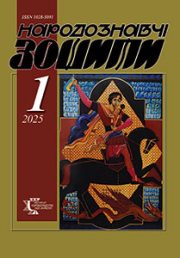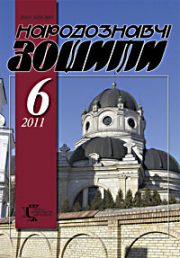The Ethnology Notebooks. 2022. № 2 (164), 480—490
UDK [738.8.071.1:688.72](477.84)”19″
DOI https://doi.org/10.15407/nz2022.02.480
HERUS Lyudmyla
- ORCID ID: https://orcid.org/0000-0002-5931-3816
- Doctor of Sciences in History, Сandidate of Аrts (Ph. D), Head of Department,
- The Institute of Ethnology of the National Academy
- of Sciences of Ukraine,
- Department of Folk Art
- 15, Svobody Avenue, 79000, Lviv, Ukraine,
- Contacts: e-mail: ludmilagerus@gmail.com
Abstract. Introduction. Clay toy is a rare phenomenon of Ukrainian decorative and applied art. The interest in the clay toy was not lost. It exists to this day (at the beginning of the XXI century) as a work of art, a cultural remembrance, as well as an object of play, a means of education.
Article purpose — to clarify the creative path of the clay toy craftsman Hryhorii (Georgy) Mykytovych Dziuma against the background of the history of the Vyshnivets pottery center (Kremenets district, Ternopil region).
The object of research is the historical and cultural aspects of the functioning of the Vyshnivets pottery center, and the subject is the artistic practice and works of Hryhorii Dziuma, the potter.
The article source base is records and photographs made by the author in 1993 during field research of the Vyshnivets pottery center, items of the Vyshnivets toy in Ukrainian museums and in the author’s private collection, including the works of potter Hryhorii Dziuma, and also historical and local lore literature, archival materials.
The formation of the factual basis of the study was carried out by methods of observation and photo fixation. The biographical method was used to cover events in the life and work of Hryhorii Dziuma. The method of art analysis was used to assess the creative heritage of the craftsman.
Conclusion. The research proves that thanks to the work of the extraordinary personality of the craftsman Hryhorii Dziuma, the Vyshnivets toy remained in its authentic state until the end of the XX century. The toys’ traditional basis was created by the craftsman is the imagery achieved using plasticity and colour. Contrary to the tendency to change the function of the traditional toy in the culture of Ukrainians in the direction of increasing decorativeness, which lasted throughout the XX century, Vyshnivets clay figurines clearly show their playful and educational value.
The works of Vyshnivets toys of the second half of the XX century, in particular by Hryhorii Dziuma, are motivated basis for continuing and nurturing the Vyshnivets toy tradition as a manifestation of Ukrainian identity in the socio-cultural space of the XXI century.
Keywords: culture,decorative and applied art, clay toy, Vyshnivets pottery center, tradition, craftsman, artistic practice, image, plastic, colour.
Received 20.04.2022
REFERENCES
- Charnovskyi, O. O. (1976). Ukrainian folk sculpture. Lviv: Higher school [in Ukrainian].
- Stankevych, M.Ye. (1993). Easter painting, embroideries and toys. In Antonovych, Ye.A., Zakharchuk-Chuhai, R.V., Stankevych, M.Ye. Arts and crafts (Pp. 69—78). Lviv: World [in Ukrainian].
- Istomina, H.V. (2009). The art of folk ceramics of Volhynia in the second half of the XIX—XX centuries. Rivne: Volyn charms [in Ukrainian].
- Herus, L.M. (2004). Ukrainian folk toy. Lviv: IN NANU; Playbill [in Ukrainian].
- Herus, L. (1993—1994). Folk toy of Volyn, Podillya, Prykarpattia. Materials of field researches pf L.M. Herus. Archive of the Institute of Ethnology of the National Academy of Sciences of Ukraine. F. 1. Op. 2. Od. save 338. Arc. 1—50 [in Ukrainian].
- Hryb, A. (2004). Dziuma Georgy Mykytovych. Ternopil Encyclopedic Dictionary (Vol. 1, p. 493). Тernopil: Zbruch [in Ukrainian].
- Herus, L. (2007). Dziuma Hryhorii. A small encyclopedia of Ukrainian ethnography (P. 726). Lviv: IN NANU [in Ukrainian].
- Kulchytska, O. (1944—1953). Drawings of exhibits of the Museum of Ethnography and Crafts. F. 3. Od. save 2. Arc. 1—102 [in Ukrainian].
- Herus, L. (2001). Folk toy, ceremonial cookies in the drawings of Olena Kulchytska. The Ethnology notebooks, 1, 175—180 [in Ukrainian].
- Pidstavka, R.V. (2014). Vyshnivets Castle: history of origin, formation and localization. Historical and cultural studies, 1 (Vol. 1, рр. 69—76) [in Ukrainian].
- Holovko, V.V. (2003). Vyshnivets. Encyclopedia of the History of Ukraine (Vol. 1). Kyiv: Publishing House «Naukova Dumka». Retrieved from: http://www.history.org.ua/?termin=Vyshnivets_smt (Last accessed: 18.04.2021) [in Ukrainian].
- Volkov, M.O. Vyshnivets. History of towns and villages of the Ukrainian SSR. Retrieved from: http://ukrssr.com.ua/ternop/zbarazkiy/vishnivets-zbarazkiy-rayon-ternopilska-oblast (Last accessed: 18.04.2022) [in Ukrainian].
- Kravchenko, V. (1924). Statistical data on factories and handicrafts of 1808—924. National archival scientific collections of manuscripts and phonographs of the M.T. Rylsky Institute of Art, Folklore Studies and Ethnology of the NAS of Ukraine. F. 15-3. Act. 160. Arc. 1—133 [in Ukrainian].
- (1940). Lists of exhibits received by the museum from other museums and institutions in 1940. Archive of the Institute of Ethnology of the National Academy of Sciences of Ukraine. F. 1. Op. 1. Od. save 2. Arc. 1—99 [in Ukrainian].
- Dyntses, L.A. (1936). Russian clay toy: origin, way of historical development. Moscow; Leningrad: Publishing House Acad. Sciences of the USSR [in Russian].
- Zhohol, L.E. (1986). Decorative art in a modern interior. Kyiv: Builder [in Russian].
- Yakel, R. «Animal style»: an exhibition of works by potters continues in the Vyshnivets Palace. Retrieved from: https://umoloda.kyiv.ua/number/3646/164/150726/#google_vignette (Last accessed: 18.04.2022) [in Ukrainian].





